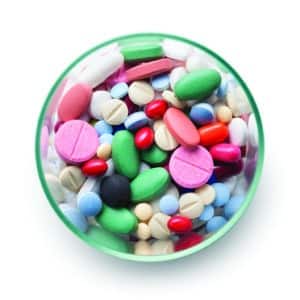An Inside Look at Prescription Drug Pushing
Table of Contents
By Gwen Olsen

“The doctor will see you now, Sara.” The impeccably well-groomed blonde, wearing a stylish summer suit, high heels, and pantyhose in 90-plus degree Texas heat, was quite a contrast to me and the other shorts and T-shirt-clad patients waiting to see the doctor. Sara quickly gathered her detailed bag and jar of candy. Grinning and chatting with the receptionist at the window, she deposited her candy jar and a handful of scratch pads and ink pens bearing her company’s logo and drug name at the nurse’s station, then swept past the exam rooms to the sample closet.
I could hear the doctor’s gleeful reception and greeting in the hallway before the door to the back office completely closed. This rep was obviously one of his favorites. I had been waiting over 45 minutes to see Dr Dogood. Some of the other patients waiting had been there when I arrived. Yet, Sara had gotten here only ten or so minutes ago, had left her business card at the receptionist’s window, and was already in the back talking to the doctor. Probably has a lunch appointment, I thought to myself. Just then, the deli delivery boy stumbled into the office with his arms full of boxed lunches.
As I looked up from the latest issue of Ladies Home Journal, I allowed myself to reflect back over what seemed like a lifetime ago when I had been young, naïve, and ambitious enough to be one of the best in the pharmaceutical business. Just a decade ago, Sara could have easily been me.
A Pharmaceutical Rep’s Journey
In 1985, I had joined the pharmaceutical industry at the age of 26. Although I considered myself intelligent and a fast learner, I was at first unequipped with the knowledge I needed to have even a basic understanding of the disease states and physiology or pharmacology involved in the drugs I was selling. My undergraduate degree was a bachelor of arts in Spanish and Portuguese. That meant I was completely reliant on the product managers and marketing department for the accuracy of the information I gave doctors.
Reps are trained and indoctrinated in a semi-military style. In fact, basic sales training classes are much like boot camp and are designed to weed out the faint of heart or easily intimidated, as working with the egos of doctors can wear on even the strongest self-esteem. Trainers push new recruits to the breaking point, often giving them long hours of homework assignments into the night and on weekends. Reps must videotape sales presentations and continually test their medical product knowledge. The environment is highly competitive, and large numbers do not complete all tiers of their training before dropping out from the pressure. Those that do are glorified as the “best of the best” and are then unleashed on the medical field with a false sense of bravado that soon fades.
Reps are instructed to promote the company’s products in a given manner and with a particular focus. This is called marketing direction. During each promotional period, there is a “tagline” or special message that the rep is supposed to drive home to the doctor. Sales literature and visual aids are all geared toward the promotional message, and they are utilized in role-plays until the presentations flow naturally. Reps are taught to handle and minimize the objections physicians might have. They are given the specific wording that best represents the company’s position. Often, these instructions come from the legal department, which reviews the sales documents for legal accuracy. If a visual aid initiates too many negative questions from physicians, the bar graph, product comparison, and so forth are reworked for the next sales quarter in a way that presents the information in a more favorable light. Having already learned the manipulative advantage of semantics in my study of language, I soon learned the semantics of research were called statistics.
Most doctors would deny the influence that sales reps have on their prescribing behavior. However, a fact of human nature is that we tend to support people that we like and feel are supportive of us. The pharmaceutical industry knows this all too well, and it provides the means for busy doctors to be accommodated in their practices by helpful, attentive sales professionals. Some reps go to great lengths to access and influence physicians because pharmaceutical companies provide lucrative incentives for reps who reach sales quotas. A rep stands to make several thousand dollars in one lump sum as a bonus in addition to his or her quarterly salary. Merchandise from catalogs and trip incentives are common as well. Reps who don’t meet quotas are looked down upon in group settings and eventually are informed they have no job security.
Not only do reps provide lunch, medical education, tools and devices, medical textbooks, drug samples, calendars, scratch pads, and pens, but they can also influence the doctors’ personal lives. In spite of the voluntary guidelines instituted by the Prescription Drug Marketing Act several years ago, which require that gifts given to doctors remain of nominal (less than $25) value, reps make generous contributions to office parties, fund-raisers, and golf tournaments, with the assistance of corporate funds. They provide tickets to local sporting events and entertainment venues, with a little creative financing and expense hiding, and they coordinate social functions such as boating, fishing, and hunting expeditions disguised as continuing medical education opportunities.
Even the most ethical, prudent practitioner can be influenced by interacting with a pharmaceutical rep—sometimes even against his/her better judgment. One of my most painful memories as a sales rep was an illustration of this very point. I was new to the pharmaceutical industry and had attended my first new drug launch. I remember the pride and exuberance I felt at the national meeting, in which loud speakers pumped out motivating theme music and medical researchers and marketing managers gave exciting, emotional speeches. I soaked in every word with anticipation and awe. I believed this new drug was really going to help people!
During the breaks, scientists and corporate executives chatted amiably with reps while feasting on an elaborate array of snacks and beverages. Sumptuous gourmet meals and nightly entertainment further catered to the already inflated egos of the sales force. Open bars accompanied every event. T-shirts and ball caps emblazoned with the Suprol logo were distributed, along with sports bags that would transport all the rep’s acquired goodies back home.
Pumped full of enthusiasm and focused on the key opinion leaders in my community, I returned to my territory. I bombarded them with studies and marketing materials in an effort to find support for my new drug. The marketing direction was very specific. Doctors in each territory had been profiled prior to the launch, and I was well informed as to who the Early Adopters and High-Volume Prescribers (HVPs) of NSAIDs were. (Note: The majority of drug companies know just what the doctor ordered, primarily because they subscribe to prescription data service companies that provide their sales force with detailed information on what doctors are prescribing in their practices. Pharmacies sell doctors’ prescription information, allowing companies to pinpoint who is supporting their product line and who is not. Reps frequently know more about a doctor’s prescribing habits than he does himself! This data often verifies what marketers already know, and that is, when detail activity or call averages are increased in a doctor’s office, the result is generally an increase in prescriptions for the products being promoted. The more memorable the presentation or information the doctor receives, the larger the assumed impact.) I was also aware of marketing’s last-ditch effort directive to ask a reluctant prescriber to give me just one new start patient, even if it was his or her most difficult patient that had failed other therapies. The rationale was, if a doctor had success in one of his or her most difficult patients, he or she would be more inclined to write prescriptions for additional patients.
One of my doctors who practiced in a small, coastal town wrote large numbers of anti-inflammatory drugs for his predominantly geriatric population. He was an older doc himself, very nice, but set in his ways. He had been profiled as a Late Adopter/Skeptic. After a lengthy debate about the benefits of my new product, he shared his philosophy with me, which was not to prescribe a new drug until it had been on the market for a full year. This way, he could avoid the initial unknown complications that invariably surfaced with each new product. In other words, he preferred a “better safe than sorry” approach.
Still, I persisted in my enthusiasm and, as I had been instructed, asked for that most difficult patient. I didn’t leave until the doctor had committed to try the drug on at least one patient. He did finally commit, or, to use sales jargon, I closed him. I left triumphant … or so I thought.
I continued drumming up support for Suprol® and had just gotten it added to my major teaching hospital’s formulary when I got the bad news. An emergency teleconference was called, and the company announced a “Dear Doctor” letter would be sent to all physicians that day addressing “new complications” associated with Suprol®, primarily flank pain. Nearly twenty-five percent of the patients affected had required hospitalization. Flank pain is a very serious side effect because it indicates the possibility of kidney damage.
Little did I know at the time, one of the doctors who had reported an adverse event, which eventually resulted in death due to dialysis complications, was in my sales territory. I was later contacted and instructed by management to have my doctor complete an Adverse Drug Reaction (ADR) report. Much to my surprise, the doctor referenced in my instructions was the Late Adopter/Skeptic, who had promised me his “most difficult patient” against his better judgment. Even more startling would be the discovery that the patient had been his very own mother. Of course, I didn’t find that out until I visited him to do the ADR. (By the way, the ADR was a daunting ream of paperwork that appeared to be designed to discourage busy doctors from reporting. That reporting process has since been streamlined online with MedWatch.) I will never forget the betrayed look on his face or his terse remark to me that “the company’s marketing strategy had obviously been more thoroughly tested than our drug!” I was devastated and riddled with guilt. I didn’t call on his office again for nearly six months. I didn’t have the nerve!
Suprol® was eventually recalled in 1987 after it had first been banned in Europe. I found myself backpedaling in offices, embarrassed as I picked up samples. Reps were instructed to take a proactive stance with providers by pointing out the swift, decisive action taken by the company to remove the product once the adverse events surfaced. What reps were not told was that Public Citizen, Ralph Nader’s consumer activist organization, had actually sued the FDA in order to protect consumers and have Suprol® pulled from the market.
So, I was somewhat surprised later on to discover that not all of my pharmaceutical cohorts in the marketing and sales departments subscribed to the medical Hippocratic Oath: “First, do no harm.” Marketing strategies were designed to do one thing: maximize profits. If the information could have a negative impact on the bottom line, reps were instructed to downplay it. The opposite was true of even the most ridiculous perceived benefit. Patent extensions were sought for minute enhancements, and tons of marketing hoopla would tout the “new and improved” products.
Over the years, as my knowledge base grew from the specialized training I received, I started to better understand the drugs and the effect they had on the body systems. I also became more adept at interpreting clinical trial data and laboratory results. I realized that drugs that were nominally effective were touted as phenomenal progress. I observed drugs being overutilized, overdosed, and improperly promoted “off label” for indications that were yet untested and/or unapproved. I watched as year after year the FDA approved dangerous drugs that were later removed from the market. I observed the defensive cover-ups and posturing employed by the industry to save those ill-fated products. But most importantly, I witnessed the demise of a fair, balanced education in medicine.
A series of haunting images ingrained themselves in my memory banks—disturbing experiences that would completely alter my perception of medicine and the institutions that guard its ethical practice. I started awakening to the truth about the greed, deception, and corruption that permeated my industry. But it would take many years and dozens of conscience-altering experiences before I really comprehended the scope of just how much my profession affected the medical industry, and the contribution I had made to harming thousands of trusting, innocent people. That sad moment of truth had changed me forever.
“Mrs. Olsen, the doctor will see you now.” The nurse’s voice brought my attention back to the present as she gestured me toward the back. We passed Sara in the hallway on her way out, as we stopped at the scale to take my weight. Brimming with a huge smile and now hands-free of her trinkets and treasures, she waved to the office personnel, “See you next month! Hope Dustin’s team wins tonight!” she chirped to the receptionist, then exited the office out the back door. “God, wouldn’t you just love to have her job?” mused the nurse as she wistfully watched the departing fanfare. “Thanks, but no thanks,” I said knowingly, “especially not in today’s heat!”
Gwen Olsen spent fifteen years as a sales rep for many pharmaceutical companies. She enjoyed a successful career until a number of incidents alerted her to the dangers in every American medicine cabinet, and she personally experienced several life-threatening adverse drug reactions. She is a writer, speaker, and natural health consultant, and is the author of Confessions of an Rx Drug Pusher, from which several excerpts are included in this article. She may be reached at www.gwenolsen.com.
See the Well Being Journal special issue containing: “Antidepressants, Psychiatric Drugs and Violence,” by Kelly Brogan, MD and “Psychiatric Drugs, Our Children, and Marketing Madness,” by Gwen Olsen as well as read online “Profits, Not Science, Motivate Vaccine Mandates,” by Kristine Severyn, PhD





